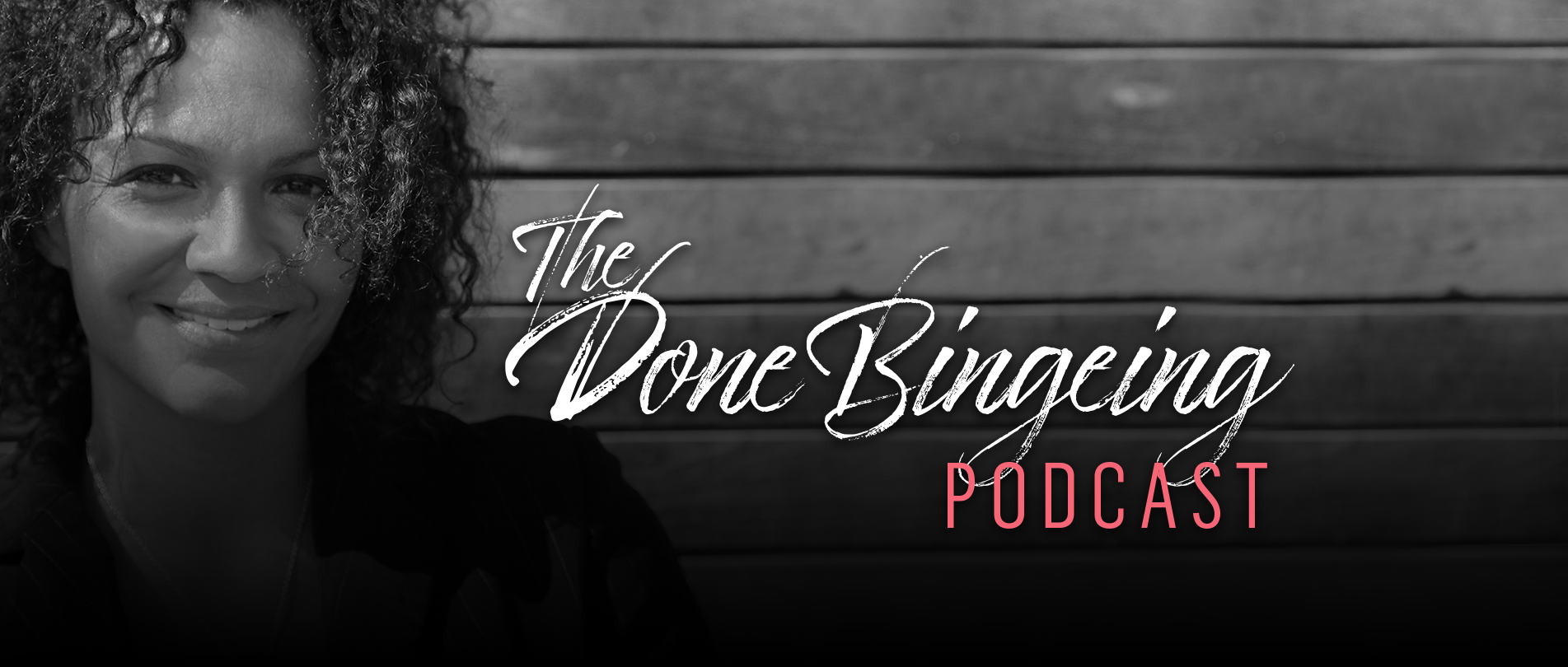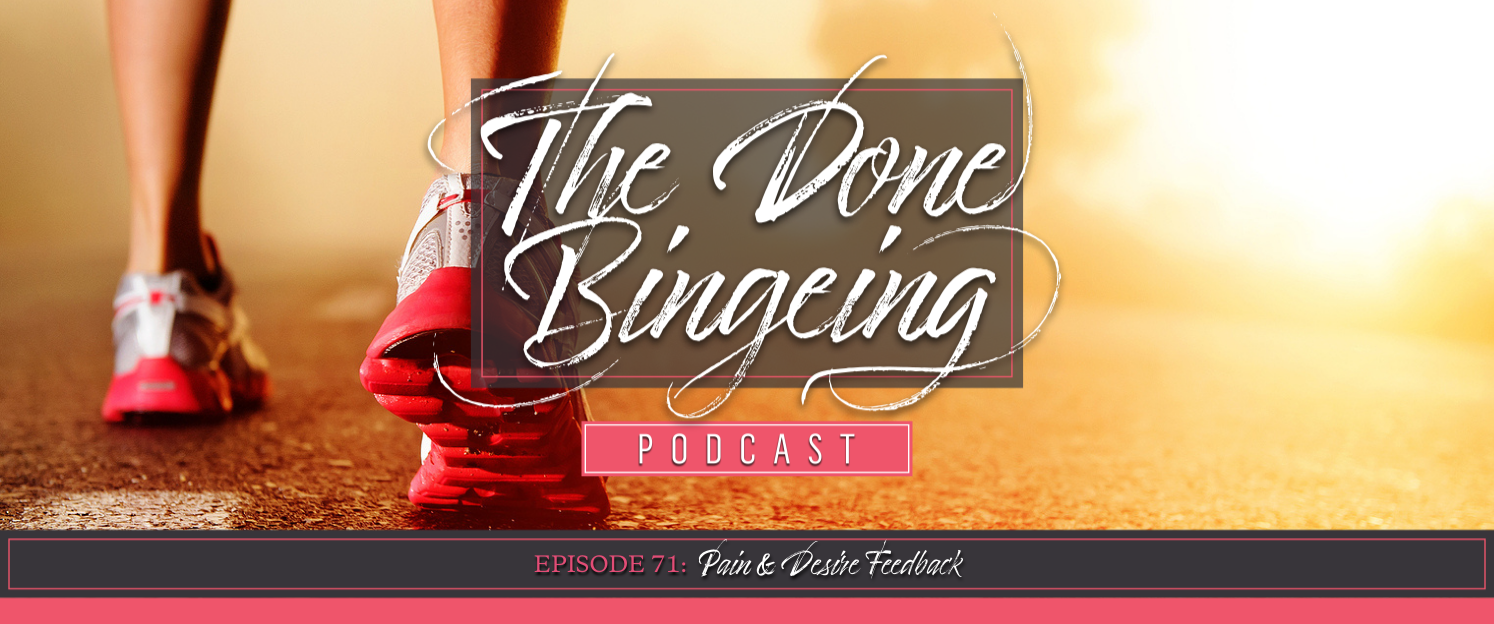
EP #71 Pain and Desire Feedback

In this episode, we briefly review the food feedback loop and take a closer look at pain and desire feedback loops.
If we fear a painful experience enough to escape it with food, our brains note that and determine that the pain is a threat. The more we try to muffle the pain with truffles, the more threatening the pain becomes. We shrink and the pain looms. And when the pain comes again, we’re already laced up and ready to race.
To not live to our full potential is to be alone inside ourselves, to lose hope in possibility, to watch dreams wash away. As Nelson Mandela once said, “There is no passion to be found in settling for a life that is less than the one you are capable of living.”
Remember Captain Marvel from back in the day when he used to wear red tights with a gold lightning streak across his chest? Well, he just yelled, “Shazam! We have our positive feedback loop.”
Listen to episode 71 of The Done Bingeing Podcast where we go deeper into painful positive feedback loops that are so common among binge eaters and where we ponder the superhero in you. Get full show notes and more information here: https://www.holdingthespace.co/71.
I may not quite be Bat Woman, but if you flash the Bat Signal across the sky, I’ll fly to your side. Go to https://www.holdingthespace.as.me/free30 and get on my calendar for a complementary consult today.
Episode: Play in new window
Subscribe: Apple Podcasts| Stitcher| Google Podcasts | Spotify | iHeartRadio | Amazon Music | Deezer | RSS
Featured on the show
- Peterson, J. B. (2018). 12 Rules for Life: An Antidote to Chaos. Toronto: Random House of Canada.
- Learn more about the Done Bingeing Membership.
- Join Done Bingeing on social: Instagram| Facebook | Pinterest
What do Nelson Mandela and Captain Marvel have to do with you and binge eating? Keep listening!
Welcome to The Done Bingeing Podcast. This is the place to hear about how you can pair the emerging brain science about why you binge with powerful life coaching to help you stop. If you want to explore an evidence-based, non-clinical approach to end binge eating, you’re in the right place.
It’s time to free yourself. You have more power than you know. To find out more, go to www.holdingthespace.co and click Programs.
And now, your host, Internal-Family-Systems-Level-3-Trained and Master-Coach-Certified Martha Ayim.
Hey friends! I hope you’re doing amazing.
In the last episode, we talked about three positive feedback loops that are central to the experience of many binge eaters:
- the food loop
- the emotional pain loop and
- the urge or desire loop
I went into the most detail about the food feedback loop and only sketched out the urge and pain loops.
In this episode, we’re going to:
- briefly review the food feedback loop and
- explore the urge and pain loops more thoroughly
The food loop
As we discussed, the food loop can begin with eating more food than we need, especially of synthetic, highly processed food that’s been designed to exaggerate the pleasure ordinarily experienced when eating.
The pleasure from the food is amplified as it was manufactured to. We get the explosion of pleasure that dulls or numbs any emotional pain that may be present and—bonus!—we get a spike in energy.
No wonder we’re inclined to enjoy this meal more than an average one!
This amped-up enjoyment may be especially compelling for someone predisposed to it, perhaps with a family history of bonding around big meals, solving sadness with sundaes, and celebrating achievement with apple pie.
The typical outcome of this loop, though, is:
- an energy crash
- a marked drop in pleasure, and
- a seeping or surging return of emotional pain
In a way, there’s a food withdrawal that comes when the effect of the food wears off.
On top of that, judgment, from ourselves or others, for getting so much pleasure from food and eating far more than we need can leave us feeling embarrassed and ashamed. This only inflames our already-difficult experience of food withdrawal.
With an outcome like this, we may go back for more food to resurrect the pleasure, re-energize ourselves, and leave the pain in the dust again.
When eating more becomes the treatment for the struggle that overeating caused, the positive feedback loop is closed.
This loop can get more pronounced, where the treatment deepens the struggle, and we can find ourselves sinking into a binge eating groove.
The emotional pain loop
Let’s flesh out the emotional pain loop we touched on last week.
Before the loop even materializes, something difficult may have happened.
Maybe a success but no one to share it with.
Maybe something new, like starting college, getting married, moving to a new home, having a baby, starting a new job.
Maybe a loss, perhaps of a partner, a friend, a parent, a job, or a pet.
Maybe a memory of being put on a diet and in a girdle at 4, of being teased at school and punished at home for being chubby.
Something happens that leaves us distressed.
Then maybe something happens that deepens this distress. Perhaps:
- Walking by an outdoor café where friends toast happily
- Learning that almost half of all marriages will end in divorce or separation
- Sleeping fewer than four hours a night for weeks
- Getting homesick
- Seeing couples tenderly hold hands
- Watching commuters board the train for work
- Overhearing colleagues whispering about our weight
Tough feelings, such as loneliness, confusion, fear, sadness, and rage, intensify.
Maybe realizing the depth of the feelings magnifies them even more and the reassurance of a friend or professional doesn’t stick and, sooner or later, it all happens again.
If we fear the painful experience enough to escape it with food, our brains note that and determine that the pain is a threat. The more we try to muffle the pain with truffles, the more threatening the pain becomes. We shrink and the pain looms.
To not live to our full potential is to be alone inside ourselves, to lose hope in possibility, to watch dreams wash away.
As Nelson Mandela once said, “There is no passion to be found in settling for a life that is less than the one you are capable of living.”
When we try to escape the pain, it only makes our pain bigger, which may leave us more inclined to run further, faster, harder.
And when the pain comes again, we’re already laced up and ready to race.
Remember Captain Marvel from back in the day when he used to wear red tights with a gold lightning streak across his chest?
Well, he just yelled, “Shazam!”
Why?
Because, presto, we have our emotional pain feedback loop.
The urge/desire feedback loop
Now, let’s flesh out the urge, or desire, loop.
One day, we may see, smell, or taste a particular food and have an urge to eat it or eat more of it even if we’re not hungry.
Our imagination can intensify the urge with elaborate visions of food and fantasies about its smell and taste.
The urge develops into a desire, a longing, that’s intense enough to feel painful in its own right.
This desire can be amplified by social expectations that pressure us, and by internal beliefs that implore us, to turn to the food. For example:
- This will help me celebrate.
- This will make me feel better.
- Food keeps me company.
- I don’t want my friends to think I’m weird if I don’t eat with them.
- This will take the edge off.
- I deserve it.
- It’s the only pleasure I have.
- It’s the only way I’ll get a rest.
- I need this, I’m just in too much pain.
- Eating this will take me back to Mom.
- I’ll be a bad guest if I don’t eat it.
- I’ll be wasting it if I don’t eat it.
- I’m not going to have a chance to eat this again for a long time.
- It will be too hard not to eat it.
- It’s going to taste so amazing.
If we fear the intensity of the calling desire for food enough to answer it with food to make the calls go away, our brains note that and decide that the calling desire is a threat. The more we flee from desire, the more threatening desire becomes. Once again, we become less of who we are and the desire becomes more than it is.
By the next time we feel desire for food, we’re already saddled up and ready to bolt right out of the gate.
Shazam! Captain Marvel and those red tights are back.
Each of these is a positive feedback loop that has us circling back to eat more food so we can:
- get pleasure
- numb pain and
- satisfy desire
Notice there’s no shaming necessary when witnessing how we, or others, get locked in these loops. These loops make sense in terms of how they develop and how they’re reinforced.
Even so, they’re still a Triple Shazammy Whammy.
But did you know that SHAZAM is an acronym for the powers that come from six legendary heroes?
Well, it does:
- Solomon’s wisdom
- Hercules’s strength
- Atlas’s stamina
- Zeus’s power
- Achilles’ courage and
- Mercury’s speed
What if you are also your own hero, with the power to deeply understand, courageously face, and steadfastly be with the pain and longing you feel?
You are, my friend, you are.
And, in the next episode, that’s exactly where we’re going.
That’s it for Episode 71. Thank you for listening!
I may not quite be Bat Woman, but if you flash the Bat Signal across the sky, I’ll fly to your side.
Go to www.holdingthespace.as.me/free30 and get on my calendar for a complementary consult today.
Thanks for listening to The Done Bingeing Podcast.
Martha has the highest-level training in both the evidence-based Internal Family Systems approach and in life coaching, and she’s available to help you stop bingeing. You can learn more about her programs by going to www.holdingthespace.co and clicking Programs.
Stay tuned for the next episode on freeing yourself from binge eating and creating the life you want.
- Never miss an episode by subscribing via Apple Podcasts, Stitcher, Google Podcasts, Spotify, iHeartRadio, Amazon Music, Deezer or RSS.
- Leave a rating and review in Apple Podcast.
- Have a question or topic you’d like to see covered on the podcast? Send it on over to me here.
- If you found this episode valuable, it would mean so much to me if you would please share it with your friends
If you have any comments about this episode, drop me a line!
Click this link to send me an email.
Thank you so much for sharing your dreams with me.
Sending much love back to you!






















0 Comments